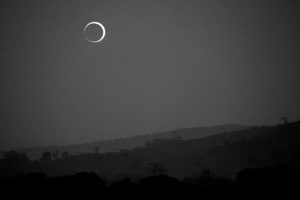An annular solar eclipse will fall on December 26, this year. It is the year’s third and final solar eclipse, though it’s the only annular eclipse occurring this year. People from the eastern hemisphere will be able to observe the phenomenon. More specifically countries including Saudi Arabia, Qatar, United Arab Emirates, Oman, India, Sri Lanka, Malaysia, Indonesia, Singapore, Northern Mariana Islands, and Guam. Cities such as Doha, Madurai, Pekanbaru, Dumai, Johor Bahru and Kuching are to miss the event narrowly.
If you are from the Kathmandu city, the eclipse will be visible from 8:43 AM and will end at 11:31 AM. However, it will visible only partially from here.

Photo Credit: Bigstock/ Underworld1 via timeanddate.com
But you can still enjoy this spectacular event. It will be 2 hours 47 mins and 54 secs long with the maximum visible eclipse time at 10:01 AM.
The path of the annular eclipse will start from Saudi Arabia and will end at Gaum. The areas where the annularity will be visible in this path are the southern parts of India, Sri Lanka, and Indonesia. The next main areas to observe the eclipse are Palau (Malaysia), Sumatra and Singapore.
So what is an Annular Solar Eclipse?
A solar eclipse occurs when the Moon passes from between the Earth and the Sun. In a solar eclipse, it is the moon’s shadow that falls on the Earth’s surface. They are only visible from the area where the shadow falls, hence, the eclipse looks bigger if one is closer to the center of the shadow’s path.
An annular solar eclipse is when the new moon covers the Sun directly from the front, but because of its smaller diameter, the outer edge of the Sun is visible, forming a ring. The annulus (ring) around the moon is also referred to as “ring of fire”.
A new moon is normally not visible from the Earth. A solar eclipse is the only time when the Moon‘s silhouette against the Sun makes it visible from the Earth. However, solar eclipse doesn’t occur every full moon night. The Moon has to be closer to the lunar node which aligns all three bodies into a straight line. In every eclipse season, there are two to three eclipses, with at least one solar eclipse.

Photo: EarthSky/ Tino Kreutzer
Five different stages of the eclipse:
- 1st Contact: The Moon’s silhouette begins to appear on the Sun’s surface, making it look as if someone has taken a bite from it.
- 2nd Contact: Full eclipse starts; begin of annularity. It makes a ring of fire appear in between the Sun and the Moon. One can also see a bead of light, Baily’s bead, for a few seconds.
- Maximum Eclipse: The center of the Sun’s disk is covered by the moon.
- 3rd Contact: The Moon begins to move away from the Sun’s disk as the annularity ends. Baily’s bead is again visible.
- 4th Contact: Eclipse ends at this stage as the moon stops overlapping to the Sun’s disk.
The total duration of an average annular solar eclipse is six hours in total. For the locations where the annularity is visible, it can last for over three hours. One must never look at the solar eclipse with naked eyes. Its rays can burn the retinas of the eyes leading to permanent damage or even blindness. Proper eye protection must be used, like eclipse glasses.


Leave a Reply
You must be logged in to post a comment.